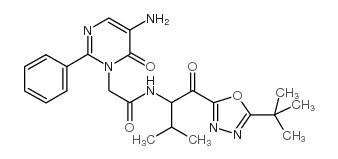208848-19-5
| Name | freselestat |
|---|
| Description | Freselestat (ONO-6818) is a potent and orally active neutrophil elastase inhibitor with a Ki of 12.2 nM. Freselestat is >100-fold less-active against other proteases such as trypsin, protein-ase 3, pancreatic elastase, plasmin, thrombin, collagenase, cathepsin G, and murine macrophage elastase. Freselestat has a potent anti-inflammatory activity[1][2][3][4]. |
|---|---|
| Related Catalog | |
| Target |
Ki: 12.2 nM (Neutrophil elastase)[3] |
| In Vitro | Simulated extracorporeal circulation is established by recirculating fresh heparinized (3.75 U/mL) human blood for 120 minutes in a membrane oxygenator and a roller pump with and without 1.0 μM of Freselestat (ONO-6818). Neutrophil elastase levels are significantly lower in the Freselestat group. Freselestat significantly reduces interleukin 8 and C5b-9 production. Freselestat does not modulate changes of CD11b and L-selectin during recirculation[3]. |
| In Vivo | Freselestat (ONO-6818; 10-100 mg/kg; oral administration; daily; for 8 weeks) treatment attenuates dose-dependently HNE-induced increases in lung myeloperoxidase activity, hemoglobin, and neutrophil count in bronchoalveolar lavage fluid. ONO-6818 inhibits acute lung injury induced by HNE by minimizing lung hemorrhage and accumulation of neutrophils in the lung[1]. Animal Model: Male Wistar rats (228 g) induced by human neutrophil elastase (HNE)[1] Dosage: 10 mg/kg, 100 mg/kg Administration: Oral administration; daily; for 8 weeks Result: Attenuated dose-dependently HNE-induced increases in lung myeloperoxidase activity, hemoglobin, and neutrophil count in bronchoalveolar lavage fluid. |
| References |
| Density | 1.32g/cm3 |
|---|---|
| Molecular Formula | C23H28N6O4 |
| Molecular Weight | 452.50600 |
| Exact Mass | 452.21700 |
| PSA | 146.00000 |
| LogP | 3.16880 |
| Index of Refraction | 1.633 |
